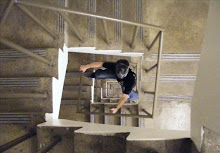Thursday, February 25, 2010
Scene
The classroom is capacious, walls stretching 50 or 60 feet away from the large, black double doors, ending in a wall made up mostly windows. But despite the windows, light still remains scarce, and what light there is casts long shadows amongst the students and still-lifes in the late afternoon sun. The lights high overhead are off for this very purpose.
The walls, unlike the floor, and covered haphazardly with portraits and projects, black graphite shining with a slight glare. Some of the drawings reflect the room itself, depicting the several piles of objects throughout the room; chairs and vases and flowers and bolts of cloth and boxes and stools. The desks of the room encircles one or other of the still-lifes, and once students seat themselves, they begin to pull out their supplies. Pencils roll on the tilted surface of the desks as they are placed, and loud slaps ring out as 18 by 24 inch sketch-pads are hurriedly brought out.
The students begin to lean over and begin their work, flipping open the sketch-pads to the proper page mirroring the group of objects in front of their respective stations. The only sounds in the room are the scratching of pencil on paper, the quick breathing of the prospective artists, and the constant churning of the air system. The teacher hasn't even arrived yet.
The room is not yet filled; half of the 30 desks remain empty. They are the desks of those who already finished their work, with no need to come in before class and scramble to finish their work. Those who haven't finished continuously glance towards the single clock above the doors, seeing how much time they have, before bending down to work again. They don't have much time.
Tense minutes pass as furtive pencil strokes replicate on paper what the students see in front of them. Some lean back from their work and let out a sigh of relief as they manage to complete the drawing. Most do not. The students who already finished are starting to arrive, placing their complete work in a pile near the door, standing idly near their old work stations, watching the people who are still trying to finish.
A few more minutes pass, and then the large black double-doors burst open, then shut with a loud thud behind the tall, dark figure who entered. She stands directly beneath the clock, emphasizing with her presence what the panicking students have been dreading.
"Time's up children," she said, raising her voice above the churning of the air system, echoing around the capacious room. Sighs of regret follow.
Tuesday, February 23, 2010
Wolves Are Back

Much of this post is based off of or a response to the National Geographic article "Wolf Wars," should anybody be interested in reading it.
People feared wolves. Their fears were amplified by ancient superstitions and stories, and they reacted violently to these ancient predators. By the 1930s, wolves were exterminated from the lower 48 states. They were treated as vermin, as an infestation. The land lost a crucial element of the ecosystem.
Then, in 1995 and 1996, the U.S. Fish and Wildlife Service captured 68 wolves in Canada, and brought them to Yellowstone National Park in an effort to bring back the wolf population.
The wolves brought down were split into groups of alpha males and females, spreading out gene pools so as to cut down on inbreeding. Sometimes, the grouping worked, and sometimes it didn't. In all cases, the wolves began to flourish. By the end of 2008, there were more than 1,645 wolves recorded in the northern Rocky Mountain states, and not all of them were confined to the national park.
Hunters are one of the loudest voices in the opposition to the return of wolves. They view the new wolf population as four-legged killing machines, "land piranhas," ravaging the game population. States such as Idaho and Montana have set quotas for legal wolf hunting, and have allowed for the extension of the legal season several times. In Wyoming, wolves were declared as pests, and unlimited shooting of the wolves was allowed; a repeat of the attitude and regulation in the early 1900s. After several lawsuits, wolves were placed once again on the endangered species list in Wyoming, and they will remain there until Wyoming legislature agrees to change its regulations.
In the end, this tells me that hunters and supporters of sport hunting are complete hypocrites. The industry may bring in an estimated $11 million per year, but the competition will not only cut down the elk numbers--which have become a burden on the ecosystem--but will also bring better regulation of the shooting of big game in the US. It will make it so that the people who hunt for food or a living will be given the opportunity they deserve, while at the same time cutting down on the amount of game or sport hunting taking place. I'm not saying that hunting is bad, but the rules and regulations defy the laws of nature, and are unhealthy for animal populations.
Because of the 1970s regulation limiting the shooting of elk females, the elk population of Yellowstone and surrounding areas doubled. The numbers had grown to the point where the elk have become a burden on the ecosystem. Elk in Yellowstone over-browsed the stream-side willows, making it so the streams grew wider and shallower, cutting down on the populations of various fish species, as well as the beaver population. Aspen trees were becoming a dying breed, as elk ate the sprouts before they had a chance to grow. The area was overrun with elk, and with no reason to move on, they over-grazed fields and vegetation, leaving nothing to grow behind.
Now, with the introduction of wolves, the elk population has been cut in half. Now, elk don't linger long at stream sides and grazing areas, allowing a healthy cropping of vegetation without endangering the area. Beavers and trout are now flourishing, because it's dangerous for elk to stay too long along the streams. Aspen trees are now being given time to grow, as they should be.
A lot of the outcry against wolves is because of the marked decrease in elk numbers. This is because elk are not used to being hunted at any time of the year. They had no way to counter the wolves. We had removed a natural predator the elk had survived against for ages, and they became lazy. After the initial decrease, the elk are becoming less vulnerable prey. They are now more vigilant than ever, and stay on the move. Before the introduction of wolves, park officials were culling elk by the thousands. Now, they no longer need to. And not only that, but the wolves regulate their own population as well. "We have a declining wolf population," said Doug Smith, leader of the Yellowstone Wolf Project. "Numbers never got as high as we expected based on the availability of prey. This suggests that once the wolves reach a certain density, you start to get social regulation of their numbers." This to me, seems an improvement over the only other real hunters that elk knew. At least the wolves only take what they need, and they keep the hunters' number from rising too high. I'd love it if sport hunters started hunting each other to keep competition down and save the big game populations :P
Ranchers have a more reasonable objection, in my opinion. For them, the killing of their livestock is a direct attack on their livelihood, and it always hits some much harder than others. However, the reasons for the panic is much the same reason as for the hunters: we're not used to it. In Europe, there are many techniques that protect livestock. Bright flags attached to wire is a technique called fladry, and it has been successful in the areas applied. In addition, electric fencing protects calving pastures, which prevents many wolf attacks. And by removing the carcasses of cattle brought down by disease or accidents, ranchers can avoid attracting the attention of wolves in the first place. They also use the rancher rider program, in which a rancher monitors the whereabouts of wolf packs in relation to the cattle and reports to other ranchers so they can move their herds if need be.
And ultimately, the greatest defense against wolf attacks to evolve is the change in cattle behavior. Since they've been domesticated, and since the extermination of wolves in the lower 48, we've removed a large reason for cattle to retain any instinctual defense. Once again, they're just not used to it, and wolves have taken advantage of this. However, as time passes, the cattle are growing into less domestic animals, capable of defending themselves and their young. And this might even be a good thing for ranchers and livestock owners, preventing us from taking too many of the animals we've come to rely on.
But before you go and think that wolves have been ravaging the herds of livestock, be aware that in Idaho, Wyoming, and Montana, where wolf population has flourished, wolf kills account for about 1 percent of livestock loss. In sheep flocks, for examples, wolves are behind coyotes, cougars, weather, disease, old age, and lambing complications in amount of sheep killed, each of the listed accounting for 25, 1.4, 22.6, 11, and 9 percent, respectively.
Wolves are an integral component of our ecosystem, and by removing them we left a gaping hole in the balance of nature. Wolves are meant to be here. And all the other large mammals are changing their behavior to deal with the wolves: elk, bison, deer, and even cattle, whom we have domesticated. Instead of griping about a force of nature that we've tried once again to control, maybe we need to start living with the forces of nature.
Monday, February 8, 2010
Looking Upward
President Obama proposes to increase NASA's budget to more than $100 billion over the next 5 years, but his plans for spending come with several cuts and refocusing of the program's projects.
Among the projects scrapped will be the Constellation program, a research program focusing on human spaceflight technologies, most notably new spacecraft and booster vehicles to replace the 30 plus year old space shuttles and take astronauts to the moon, and ultimately Mars. Eliminating this program effectively eliminates NASA's manned flight programs to the International Space Station (ISS), the moon, and beyond.
NASA will now be focusing on other projects, including the increase of the life of the ISS until 2020, the development of new unmanned ships, and improvement of advanced robotics. Worthy goals all, but sidelining the development of actual space travel.
With the plan to scrap the out-of-date space shuttles continuing, soon the US will have no means to actually get to the ISS, their largest space-oriented commitment, other than to hitch a ride with other countries. Bolden promised that humans would "[fan] out across the solar system" with the help of "nations around the world," with little hint of which nations he meant.
In addition, NASA is abdicating its role as a developer of new manned booster and spacecraft technologies, instead relying on private companies and suppliers to come up with new rocket ideas, most notable United Launch Alliance (ULA). Although ULA has already been regularly supplying the military with new rockets, they have yet to test manned rockets as a means of space travel. The reliance is risky, and driven by the hope that private companies can move more quickly and cheaply than NASA.
Time Magazine
The New York Times
Former NASA director Mike Griffin deplores the policy, stating, "With this policy the U.S. human space-flight program is grounded indefinitely, because no date for the availability of commercial human spaceflight can be reliably predicted."
No where in his statement did Bolden even attempt to set a deadline or a concrete goal, instead just saying a lot of words that give a vague impression of the future, in which humans span the stars. That's all well and good, but nothing to inspire people like John F. Kennedy's words, "We choose to go to the moon. We choose to go to the moon in this decade and do the other things, not because they are easy, but because they are hard, because that goal will serve to organize and measure the best of our energies and skills, because that challenge is one that we are willing to accept, one we are unwilling to postpone, and one which we intend to win."
I agree that "mothballing" the space shuttles is the correct decision, maybe even a little overdue, since they were designed in the 50's with construction beginning in the 70's, but without a replacement program, we're basically stepping aside to let others do the exploring.
That's not right. I want to get out there, I want to go to space.
As one of my favorite people said, "With everything going on in the world today, some might applaud this approach. Why invest in space when the education system is so underfunded?
To that I would answer: 'To get children excited about learning again.'"
"I want my child looking upwards, never knowing what's there, but knowing that he can find out."
Left- vs Right-Handed Death Rates
Visual: a bar-chart showing average age at time of death for left- and right-handed men and women.
By David Blackwell
A recent study shows that people dominant with their left hand may live an average 6 years less than those dominant with their right hand.
The study, conducted last year, compares the death and accident rate of left- and right-handed people. California State University psychology professor Diane Halpern and University of British Columbia researcher Stanley set out to discover why there are fewer left-handed people amongst the elderly.
The researchers began their study by examining death certificates of 987 people in Southern California, as well as talking to relatives of the deceased via mail. In the end, they concluded that on average, left-handed women and men die at 72 and 62 respectively, while right-handed women and men die at 78 and 73 respectively.
"The results are striking in their magnitude," said Halpern. Left handed people, who make up over 10 percent of the population, are 4 times more likely to die in car accidents and 6 times more likely to die from accidents overall.
Halpern said, "Almost all engineering is geared to the right hand and right foot. There are many more car and other accidents among left-handers because of their environment."
However, the conclusions from this study should be applied cautiously. "It should not, of course, be used to predict the life of any one individual," Halpern said. "There are many, many old left-handed people."
Wednesday, February 3, 2010
Joined at the Soul by a Pair of Headphones
Dub Fx is an Australian born musician who started out, originally, as solely a singer and guitar player for a reggae band in high school. Now, he is so much more.
Dub Fx busks all throughout Europe, avoiding big record labels and signing companies like the plague. He won't go near them; for him, the streets is where he created his music, and it's where he wants to stay. Dub Fx uses effects pedals and his natural beatbox and singing talent to create and layer the beats and harmonies that make up a song. He creates all of the beats on the spot, no pre-recorded music, and that lends him creative leeway that most artists seem lack these days. Using the loop he can layer anywhere between 5 and a dozen different levels of music. When listening to his music, it's almost impossible to think that it's only one man.
He's produced his two albums thus far independently, and has every intention of continuing to do so. He sells his work through a website he created with a couple other artists, Mr Woodnote and Cade, as well as the man who films his videos, Ben Dowden. You can find his work here: www.dubfx.net
Dub Fx works often with Mr Woodnote, a man of similar talents to Dub Fx, with the addition of a saxophone to the mix. He too layers his music with the loop function, lays down phat beats with his own voice, and then solos over it with his sax, creating a beautiful blend of genres that is truly original and creative. You'll be hard pressed to find anything else like it.
A friend of mine sent me a YouTube video of Dub Fx yesterday, and I've become obsessed with his work. I truly enjoy listening to the music I've downloaded, but the real treats comes from watching him and Mr. Woodnote perform, because that's the way the music is meant to be experienced. On the street, where anyone can listen to it, where it was created. I want to share this with as many people as I can, because I feel that these guys are going to become huge someday, major influences on music and attitude, both in the performance and the industry.
Watch these videos. See if you agree.
Flow, ft Mr Woodnote
Hip Hop
Rude Boy
Get Down
Wolf
Tuesday, February 2, 2010
Research Practice Take 2
a. What is the total population for your state based on the most recent census statistics available?
Based on the 2009 census, the population of Colorado is 5,024,748.
b. What was the population of Asian and Pacific Islanders in your state in 2000?
128,135 = 2.6% for the former & 4,675 = .1% for the latter.
2. Crime Story
a. Find a site that lists sex offender registries in the U.S. What is the URL?
If anyone out there is concerned for the children in college, which, given that they're in college, you should be if even just a little, you can get a good idea for the sexual offenders in your child's area with this site or this one.
The sites go into detail about the nature of the offender's crimes, whether they be violent sexaul abuses, multiple abuses, etc etc. I checked the immediate area around my home, where I live next to Boulder High School, and found to my lack of surprise that sexual assaults are not unknown. Check it out. You can even see how to use the interactive map to your advantage by clicking here for an example.
3. Crime Story 2
If parents are still concerned about their students and want to see what kind of campus their child is attending, they can easily check several databases about the number of crimes on campus. They can go to the U.S. Department of Education's home page and check for statistics for any individual school. For example, the statistics for the University of Colorado at Boulder can be found here. However, it would be prudent of parents to also check the college or university campus security, as some crimes do not go beyond campus security. For the University of Colorado at Boulder, you can check their statistics page. (Note: if this link just goes to a search page, as it sometimes does, just search "police statistics" and click "campus security.")
In 2008 at CU Boulder, there were 7 forcible sex offenses, or rapes. If you're checking the US Department of Education's page, then there were 59 burglaries on campus in 2008, but according to the CU website, there were only 44. However, CU's page claims there were 446 thefts recorded, while the Department of Education's page doesn't even list that statistic.
4. Political Reporting 1
Opensecrets.org tells us that Michael Bennet’s campaign committee raised $3,661,380 from 2005-2010. Mark Udall’s campaign committee, by contrast raised $12,015,829 from 2005-2010.
5. Political Reporting 2
Governor Bill Ritter Jr. raised $984,026 in campaign contributions, as you can see here. In his last election, Mr. Ritter raised $4,365,475 in campaign contributions. He must've had a lot of donations, because the limit for Colorado is $525.
Tuition costs in 2007-2008 were $16,245
Average public tuition at four-year institutions for fees, room and board in 2007-2008 were $13,424.
Average fees, room and board for four-year public tuition were, in 2007-2008, a startling $30,393.
You can find the information here.
7. Government Statistics 2
Homepage for the state of Colorado: http://www.colorado.gov/
8.







